Gunsmithing: Rifles, 9th Edition is the latest edition of Patrick Sweeney’s long-running gunsmithing book series.
Do you have a rifle that just won’t group, no matter what you try?
From hunting rifles to tactical and benchrest precision, even today’s modular AR-15 and AR-10, author Sweeney covers them all and shows you how to gunsmith your own rifles at home and make rifle upgrades that maximize their true potential.
Learn how to repair wood stocks, bed a rifle for accuracy, tune a rifle’s trigger, select aftermarket parts that will enhance your rifle-shooting ability, upgrade Ruger’s 10/22, accurize a precision bolt action, make AK-47 and AK-74 enhancements, install slings, rails, and suppressors, and more.
To order Gunsmithing: Rifles, 9th Edition, click here. Enter the coupon code “TTAG” to get 15% off the total purchase of any product(s) for TTAG readers.
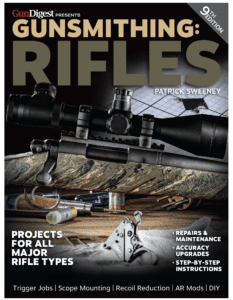 The following material from Gunsmithing: Rifles, 9th Edition is from Chapter 12, “Accuracy Testing” and reprinted with permission of the publisher. Copyright 2019, Gun Digest Books.
The following material from Gunsmithing: Rifles, 9th Edition is from Chapter 12, “Accuracy Testing” and reprinted with permission of the publisher. Copyright 2019, Gun Digest Books.
Accuracy Testing
You go to the range for one of two reasons: You either want to test yourself, or test the rifle. If you are testing yourself, then you would shoot from whatever positions your competition requires or hunting experiences have called for. You shoot at a target that is the same size as the acceptable target you are shooting at in a match or during a hunt.
To practice for many rifle matches, you stand up and shoot offhand. One of the favorite activities of the members at my gun club is offhand shooting at the gongs on the rifle range. We compete against each other for shortest time to the first hit, number of hits in a row, or fastest string. The scoring is simple: hit or miss.
To properly test the rifle, you obviously need the rifle and ammunition. You also need a stable shooting platform, targets, protection for yourself, and some way to store and sort through the information you are generating. You also need a consistent technique to generate consistent results.
If you are testing the rifle, there is only one position to shoot from. Sitting at a bench. Preferably a solid bench, with solid, padded rests on which to place the rifle and your elbows. To precisely test the rifle, you want to eliminate all of the variables and errors that you, the shooter, would otherwise introduce.
The only way to really do that is with a machine rest. However, you can come quite close to the level of accuracy a machine rest would get out of a rifle using the proper equipment and technique. The target you should shoot at would not be a hit-or-miss target like a gong, but a paper target that measures the rifle’s performance.
Testing two rifles, or two brands of ammunition, and determining that any combination would shoot a group smaller than the heart/lung area of a deer doesn’t tell you much. Hitting the gong 10 times in 10 shots doesn’t tell you if one group of five shots was significantly smaller than the other. Only paper will do that for you.

If your club has solid benches resting on a concrete slab, then you are a lucky shooter. Do whatever you have to in order to stay a member of that club. Offer to maintain the benches and shooting line if you have to.
What if your club does not have such amenities? Offer to build a good bench. Construct it out of 4-by-4 posts and a double thickness of plywood. Use pressure-treated lumber if you can. If not, then give the bench several coats of outdoor porch and deck paint. When it comes to benches, heavier is better. A bench that is heavy enough does not need a concrete slab. To keep the mud down, spread wood chips or gravel in the area where the bench will “live.”
Sitting down to shoot and resting your elbows on that bench is more accurate than standing, but just barely. And just barely comfortable. The rifle should rest firmly without you having to hold it. Invest in or build shooting bags or a shooting rest. You can make a rest out of scrap lumber.
Design your rest to take some padding. Resting the rifle on a hard object can alter group size or location. It can also dent or mar the forearm of your stock. A fabricated bench rest is only a compromise, done to save money. I’m all for saving money, but sometimes money saved by making things yourself is false economy.
You save money by building a rest. What it costs you is extra time fiddling and adjusting the rifle and rest until you are on the target. The time lost and the effort spent adjusting and readjusting the rifle means less time spent shooting, and less information garnered.
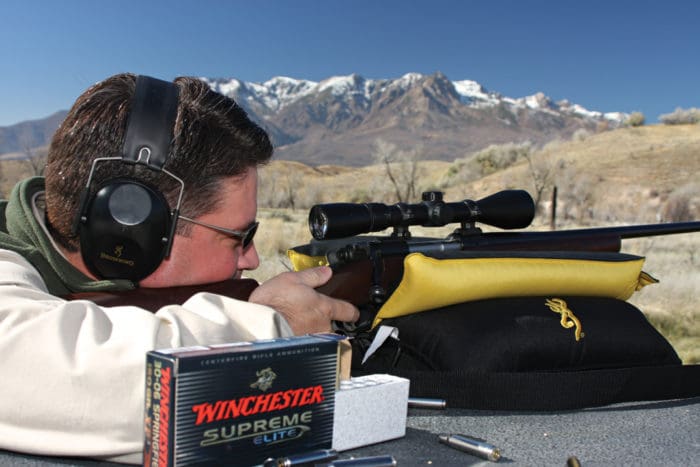
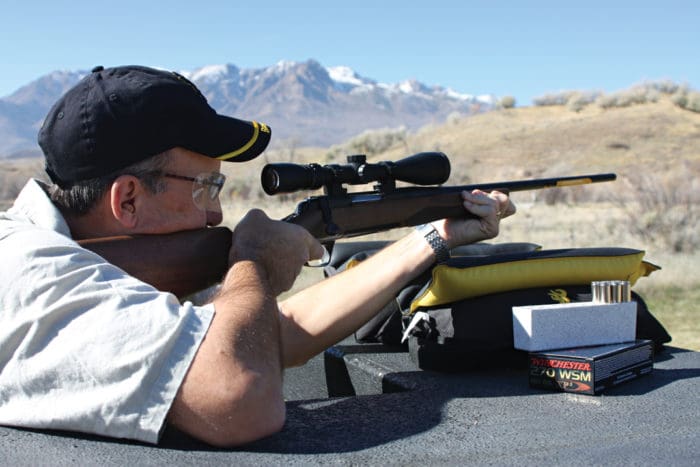
The best rest for your rifle is an adjustable rest. As a professional gunsmith, I found that a top-grade shooting rest made a big difference in comfort and ease of range testing. The Sinclair Varminter rest is top-of-the-line. Made of aircraft aluminum and fine-grain cast iron, it is solid, adjustable and comfortable to use. I don’t have to squirm around on the bench to get the crosshairs right where I want them.
Having said that, I have to admit to using a front rest made of plastic from time to time. Why? The plastic one can ride in my truck 365 days a year and not rust. If I need to do a quick zero check, I can drag it out of the truck and use it. Would I subject the Sinclair Varminter rest to the same ill-treatment? No. Would I try to sort out which rifle, or which load, is the most accurate without it? Again, no.
To squeeze the last bit of accuracy from your rifle tests, you need several shooting bags or pads. The front rest needs a bag for the forearm to rest on. The butt of the rifle needs another bag, called a “rabbit ear” bag. The rear bag is angled. The angle lets you slide the rifle back and forth to roughly adjust the elevation of the sights on the target.
Some front rests have a forward stop. The stop gives you a reference point. With the tip of the forearm up against the stop, the rifle is always in the same position on the shooting rest. You are always sitting in the same posture and position. To use a front rest with a stop, press the rifle forward to the stop. Then move the rear bag around until the sights are on the target. For fine elevation adjustments, you use your left hand (for right-handed shooters) to squeeze the rear bag.
After the recoil from shooting, push the rifle forward until it touches the stop. Check your sights and squeeze the rear bag to get the crosshairs in the center again, and repeat.
You need two elbow pads. You can use folded-up towels or sections of firm rubber padding. These pads protect your elbows from the tabletop. These pads are for comfort and to fight fatigue, not recoil. Unless you are shooting a large-caliber rifle, the recoil won’t drag your elbows across the table.
If your elbows hurt, or your arms are tired from resting on the hard wood, you are not going to be able to concentrate on your shooting. Not everyone feels the need for the next-to-last pad that I use. Some rifles, especially large-caliber ones, do not shoot their best with your left hand at the rear bag. In order to control the recoil, you must grasp the forearm. I designed a block and pad to sit under my left hand when grasping the forearm.
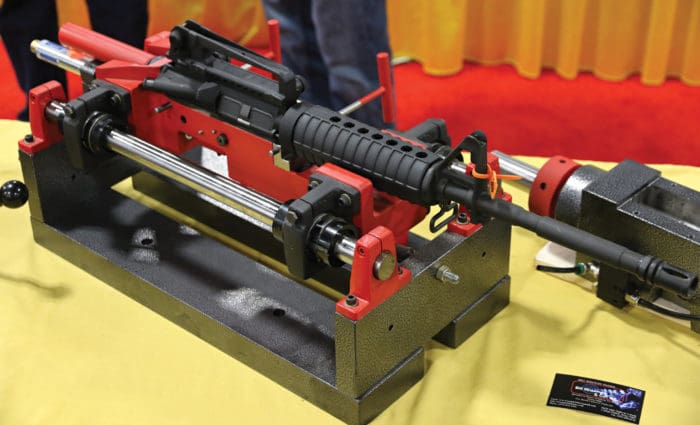
The last pad does not go on the bench. It goes on you. Yes, I know we are all tough guys (and gals) and recoil doesn’t hurt us. Like heck it doesn’t. Even if you don’t think it does, recoil tires you and makes good shooting increasingly difficult. If you want to see what large amounts of heavy recoil do to shooting skills, plan a trip to a bowling-pin match with shotgun side events.
To knock the pins off the table takes buckshot, and to down the falling steel plates it takes slugs. The fastest shooter wins, with many entries allowed. Even the best shooters pace themselves. After 50 or 60 factory 12-gauge loads, even a big, tough shooter looks whipped.
If all you do is fold a towel and put it between the butt of the rifle and your shoulder when you sit down to test your rifle, you increase the number of shots you can take before your shooting skills suffer. I have had great success with PAST recoil pads. Made of a space-age synthetic, the PAST pad will take the sting out of the recoil of many calibers.
Now part of the Caldwell family, you can buy them pretty much anywhere, and the $25 they cost will bring you many range-testing sessions of comfort, for years to come.
You need paper targets to shoot at. Target design can be a personal thing. I know successful hunters who view the expense of using anything other than a paper plate as a target as a frippery. The plates are cheap (even cheaper used!) and are the same size as the vitals of a deer.
The thing I noticed about such hunters is that they are much better hunters than shooters. After all, if the farthest deer they have ever shot has been 35 yards away, how much accuracy do they need?
We are interested in a more precise view of things.
I use two types of targets, aiming-point and grids. I spent some time developing them on my computer and printing out test targets to try at the range. The aiming-point targets come in two sizes. The first is a scope target. It has a 1-inch white square in the center, with a black square border 1 inch thick.
At 10 power on a target scope, I can place the crosshairs right in the white center square. With the center square and border each being 1 inch, I have a quick gauge by which to measure my groups. The second aiming point target is for iron sights. It has a 2-inch white square center with a 2-inch black border. It is large enough to see in broad daylight, but not so large I can let the sights “wander” around the bull.
The grid target is a checkerboard of 1-inch squares. I use it when testing handguns in the Ransom rest and rifles in the machine rest. Since the mechanism does the aiming, I don’t need an aiming point, and the 1-inch squares quickly tell me group size.
I print each from the computer onto regular paper, and then take them to the copy shop and make a bunch of copies. The master print includes spaces for all the information I need to keep. I used to keep the targets, but after I had several hundred on hand, storage became a problem. Now I simply measure the group size and record those measurements in my shooting log. These targets are cheap and easily made.
If you don’t have a computer, you can sit down with ruled paper, a straightedge and a felt-tip marker. The size is convenient, and you can staple as many as you need to a target holder without feeling like you are pasting up a billboard. And you will need a bunch of them. One target per group, to be exact. To see the groups after you have fired them, use a spotting scope. Mine is an old Freeland scope that was once used for small-bore rifle shooting.
A spotting scope gives you a better view of the target. You can have more magnification in a spotting scope than in a rifle scope, aiding your view of the target you just fired. Rather than straining your eyes through the rifle scope, or walking down to the targets and back, get more glass.
Protection of your eyes and ears is vital. I recall one instance of going to the range with my father when I was just a kid. My brother and I were shooting .22 rifles under Dad’s supervision, and even back then we had glasses and muffs on. A fellow club member showed up to sight in his deer rifle. After he had touched off a few rounds of the .300 Savage, my father went over and offered the fellow some ear plugs. “No, that’s all right.” he said, “After a while you get used to it.”
As we walked back, I heard my father remark “Yea, you get used to it by going deaf.” The noise of shooting will damage your hearing if you do not wear proper protection. Puffs of cotton, wadded-up cleaning patches or empty pistol cases do not protect your hearing. Wear muffs or foam plugs. If you shoot on a covered firing line as I do, you may want to wear both plugs and muffs over them.
One drawback to hearing protection is that you cannot hear people talking to you. Invariably, when you peel back the muff to listen, someone else on the line will touch off a 7mm Magnum. I avoided that problem with electronic muffs. The electronic muffs have electronic circuitry and external microphones built into them. The mics pick up outside noise and transmit the noise to the speakers in the muffs. If a noise occurs that is too loud for your hearing, the circuitry protects your hearing.
Most electronic muffs either clip off the extra volume or shut down for a split second. The good ones compress the noise down to an acceptable volume. You still hear what happened, but it is prevented from being too loud.
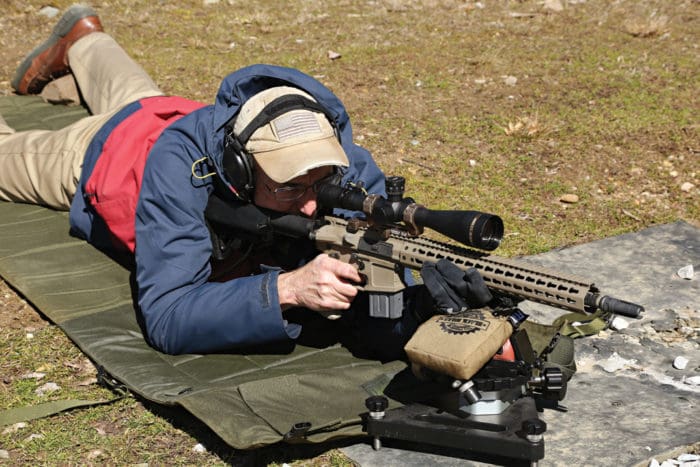
Back in the end of the 20th century, electronic muffs were expensive, fragile, not easy to find, and gobbled batteries like breath mints. Today? They are so inexpensive that they are sometimes used as inducements to subscribe to shooting magazines. At one of the last industry PR shindigs I was at, they handed out electronic muffs to all participants as part of the swag.
Some things don’t change. The less-expensive ones simply switch off when the noise gets to be too loud. Trying to listen, or talk, when your earmuffs are switching on and off, on and off, can be annoying. Not as annoying as going deaf, however. So, it is worth the extra bucks for the better ones. The “extra bucks” used to be hundred-dollar bills. Now they might be twenties and might be smaller.
As your last piece of equipment, you need a shooting log. A loose-leaf binder with standard notebook paper in it will do. If you have a home computer, you can experiment with designs of columns and boxes for the information you need. You should make entries into your log each time you go to the range. Include the day and time, the weather, which rifle you are using and what ammunition. Note how much ammunition you fire, and the results you obtained.
If you are testing for accuracy, then be sure to save the targets long enough to measure the groups and enter the measurements into the log. If you are testing ammunition over a chronograph, be sure to list the velocities along with the lot numbers of the ammo tested.
Why go to all this trouble? A rifle can be a lifetime investment, if you treat it properly. By keeping track of your practice and testing sessions, you can tell how your rifle is shooting. Is it shooting as well as it did before? Has the accuracy dropped off or improved? Don’t just try to rely on your memory. Keep a log.
Now, logs can be useful, but they need not be ultra detailed. Someone who is competing in the PRS, Precision Rifle Series, will note every round fired, time, date, location, conditions. Also, if they are borderline OCD, the results. Ditto NRA High Power shooters. They want to know if accuracy is starting to slip.
A more tactically-minded shooter simply logs volumes. They want to know when they get to certain mile markers, so they can test or inspect to see if they might need to replace this or that or rebuild something.
* * *
So, there you are, at the range with 100 pounds of rifle, bags, pads, ammunition, spotting scope and assorted other gear. That doesn’t include the weight of the bench. How do you test the rifle? To sit at the bench and shoot, you must be comfortable. Take your time and get in a good position. Sit upright. You don’t want to be in a “sitting prone” position. You’ve seen it, where they shooter is sitting down but his upper body is practically resting on the benchtop. Breathing is difficult in this position, and your neck gets tired quickly. Plant your feet on the ground or concrete. Changing your foot position can shift the point of impact.
Do not rest your body against the edge of the bench. Rest the butt of the rifle against your shoulder and move the front rest under the rifles forearm. Look through the scope and move the rest on the bench until the target is in the crosshairs. Slide the rear rest under the butt of the stock until the rifle is supported by both rests. Fine-tune your adjustments, your position, your comfort, until the crosshairs are on your aiming point.
Snuggle up to the rifle and aim at the target. Set your elbow pads down to keep your elbows off the table. With a solid rest and a high-powered scope, you should be able to see the effects of your heartbeat in the crosshairs.
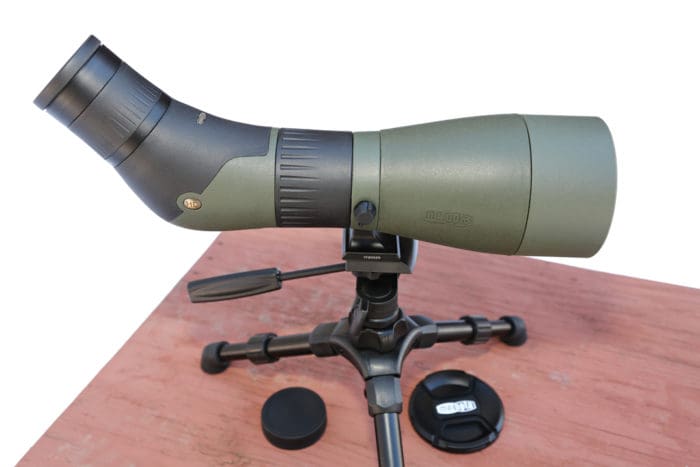
Sit in the same position at the bench for each shot. Practice by dry-firing. Make sure the rifle is empty and close the bolt. Snuggle up behind the rifle and place the butt solidly into the pocket of your shoulder. Grasp the wrist of the stock and place your finger on the trigger. Line the crosshairs up on the target. Reach under the stock with your left hand and squeeze the rear bag until the crosshairs are centered on the target. Let your breath out and continue pressing the trigger until the striker falls.
The press should only take a few seconds. Work the bolt, take a couple of breaths, and then repeat. With practice you can “call” your shots. Calling a shot means you can tell exactly where on the target your crosshairs were when the striker fell. Once you can call your shots dry-firing, it is time to go to live ammo.
I am leaving out any talk of dealing with the wind or mirage. I do this not because wind drift is trivial (it isn’t!) but because it is outside the scope of a book on gunsmithing. If at all possible, do your test-firing on a calm day or early in the morning when the wind is likely to be down. My range is completely ringed by tall berms, and the wind is not at all predictable. Not a problem, as the wind is not often strong enough to drift bullets significantly during their 100-yard journey to the paper.
How much shooting is enough? Tailor the amount of shooting you do to the information you need to know. If you are checking your rifle to see if the zero has changed since the last hunting session, a single three-shot group will do. If you are final-testing a rifle and ammunition combination to see if it is accurate enough for competition, then you should shoot five 10-shot groups. For general testing in between those two conditions, I fire three six-shot groups. Why three? Because I can’t get more than that out of a box of ammo. It isn’t a matter of division, but fouling.
When I was doing accuracy testing for handguns some years ago, I found out that many handguns had sudden increases in group size switching from one ammunition to another. I was using a Ransom rest, and the accuracy for that handgun and ammo combo would settle down after a couple of groups were fired of the new brand.
I only had to see this a couple of times to realize that the fouling for each brand was different. Until the new brand had blown out or overlaid the old fouling, accuracy suffered. I had read about fouling shifting group size when reading about benchrest shooting but had not seen it until then. This was, however, with a superbly accurate .22 LR pistol using match-grade ammo and a Ransom rest.
When switching brands or ammo lots in testing rifles, I first clean the barrel. Once the barrel is clean and cool, I fire a fouling shot. One round out of a box of 20 leaves 19 rounds. Three six-shots groups take 18 rounds, leaving one round as a spare. I could shoot five-shot groups, but that leaves four spares.
Testing for competition purposes is more rigorous. To test for accuracy in a USPSA/IPSC rifle competition, I will fire at least 10 six-shot groups. If the last group is the same size as the first, then I don’t test slow-fire any more.
If the last group is larger, then I continue testing until group size is unacceptable for competition. I then plot group size and point-of-impact changes for future match use. I have only had to do this for one rifle, and I replaced the barrel soon after going to all this work. (It was on its last legs, so no loss, and information gained. I declared it a victory and moved on.)
If the group size has not changed (which is usually the case with a good barrel), then I test it for changes from heat. Practical rifle competition is a rapid-fire sport. I test a potential rifle by firing three six-shot groups from the bench. Without cleaning or cooling it, I then fire a magazine in rapid-fire practice on other targets or on the gongs. I then sit down and fire another set of three six-shot groups. A good barrel will have a minor change of zero and group size on the second set of targets. A great barrel will show no change.
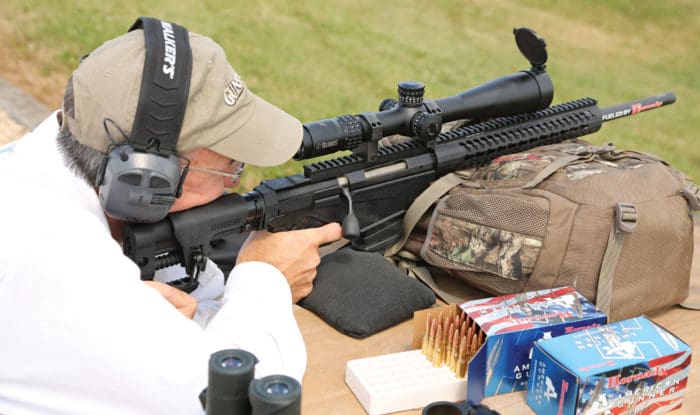
How much accuracy is enough? That depends on the rifle, ammo, and your needs and ability. An expensive rifle with a guarantee of accuracy must deliver as promised. A hand-me-down hunting rifle may be doing well if it does 3 or 4 inches at 100 yards. Be sure of the ammunition and yourself before starting to blame the rifle.
One day when I went to the gun club, one of the other members was there with an expensive rifle. It was a purpose-built, imported and expensive sniper rifle. He was not having fun, because his thousands of dollars’ worth of rifle had not shot a group under an inch yet. (As I recall, the rifle ran him right around $5,000, without the scope. The scope added another $1,200. Ammunition was “expensive” back then, with what he was using costing him 25 cents a shot. You can imagine his distress at its lackluster performance.)
I asked him if he had broken-in the bore, and his reply was “Yes.” What ammo? He showed me a box of Federal Match .308 Winchester. Hmm. The rifle and ammo should be capable of much better than an inch. I sat down at the bench, adjusted the rests a bit, dryfired the rifle a few times, and then fired a five-shot group that measured .695 inch edge to edge.
Happy as kid on Christmas, he sat down to try it himself. Later, he showed me several targets, including one that was three shots under half an inch. The rifle was up to it, but the shooter wasn’t sure he was. If he had been using a lever-action with a four-power scope on it, chambered in .30-30, his expectations of a group under an inch would have been completely out of line.
So how much is “enough?” Back in the old days, the expectations were a lot more generous. Most out-of-the-box bolt-action hunting rifles should do under 2 inches with factory ammo. Some would do an inch, but you had to search for the ammo they liked. Hunting levers, pumps and autos would probably shoot larger groups than 2 inches, with some exceptions. Browning BARs tended to shoot better than 2 inches, as did Remington pumps.
Today? Every maker offers an economical bolt-action rifle that will do an inch or less. Rifle makers, their barrel suppliers of barrel-making divisions, and the ammunition makers have all tightened things up. Shooters now expect accuracy, and they do not expect to have to pay a lot for it. It is common for a basic bolt-action rifle, with an MSRP under $500 (some under $400) to shoot 1-inch groups.
A trued-action rifle with lapped bolt surfaces should do under an inch. The same rifle with a premium barrel had better do under an inch, or someone somewhere forgot an important step. It should easily do under half an inch, with the right shooter sitting behind it.





Good read and information for many shooters. Most the information reaffirmed what I already knew or have learned through the years.
Question to people would be what shooting rest do you use when shooting from a bench? Pro & cons of it.
I bought the Caldwell Deadshot combo (front & rear bags) many years ago. Hate it. The front bag wobbles/moves too much under recoil (.308).
Borrowed a friend’s Caldwell TackDriver to test. Worked great for AR platforms as the wider handguard fit nice and snug in it. No movement whatsoever. It didn’t work worth crap for my hunting rifle though. Too much space between the sides of the bag and the stock of the gun. Also, the slope of the forearm on the gun (Winchester Model 70) didn’t allow for much of the stock/forearm to rest in contact with the bag.
Shooting rests can take many forms, and the benchrest and F-class communities have really put significant effort into their rests and the stock profiles to fit into their rests.
Seb Rests are some of the highest-end rests out there in the benchrest game. I recommend looking them over to see what features benchrest/F-class shooters look for in a rest, because Seb has made a business of responding to these feature requests for years now.
“A fellow club member showed up to sight in his deer rifle. After he had touched off a few rounds of the .300 Savage, my father went over and offered the fellow some ear plugs. “No, that’s all right.” he said, “After a while you get used to it.””
Read a history on the WW2 war effort, on training the new people to buck rivets in aircraft. They complained it hurt their ears the first few days, but then it didn’t bother them any more…
Whatever. Piss off, coward!
What?
Is that because they lost hearing, or the body adapted somehow? Now I want to get a book on WWI and WW2 and hearing damage. Anyone know of such a thing?
The body adapted by going deaf.
Your hearing does adapt to change the pain or discomfort threshold, but the mechanics of losing hearing won’t change.
In your inner ear, the way sound is turned into nervous impulses sent to your brain is by fluid in the inner ear being pushed in waves over very fine hairs that are connected to nerves. The hairs/nerves that sense high-pitched frequencies are the closest in your inner ear to your outer ear, and this is why, when you’re exposed to repetitive damaging levels of noise, you lose your high frequency hearing first.
What happens when your have extended exposure to noise can be one of several things:
– your hairs in the inner ear eventually get broken/sheared off (and you lose most all response to that frequency band)
– your nerves become fatigued and confused, and you end up with tinnitus. I have this, and it is often as annoying as hell. You might still be able to hear higher frequencies, but you hear internally-generated ringing that obfuscates the sounds you want to hear
– Some other mechanism; there are mechanisms of hearing loss still under research.
As an example: I have never met a veteran of the air war over Europe who didn’t need hearing aids from the 1970’s onwards (they might not have had hearing aids, but they needed them). They all went progressively deaf, some profoundly so, by their mid-late 50’s. Browning .50’s look like lots of hearing damage to fire, but when you’re in an airplane with a howling engine (or multiple howling engines – remember, aircraft engines have no muffler on them – just short stacks on top of the exhaust manifold), a whistling prop, the white noise of air rushing over the airframe, etc – the noise of 50’s is just icing on a multi-layer cake of hearing damage.
Hearing loss is cumulative – you start working in a high noise environment, and you become adapted to it, then you start stacking up hearing loss… but let’s say you quit that environment and go do something quiet.
Later in life, you do something else to insult your hearing – and “suddenly” you have tinnitus or hearing loss. It actually isn’t that “sudden” – it’s just that you reached the point where your ears will withstand nothing more, and they let you know it.
If I understand the article correctly, it tells us that sturdy bench shooting rests obviously provide incredibly stable support for rifles which is critical for determining accuracy. What I did not see in the article is the potential importance of holding the fore-end of the rifle — how that might affect accuracy and how that might affect point-of-impact.
When you shoot your rifle on a solid bench rest without anything holding the barrel down, recoil will begin raising the barrel before the bullet even exits the barrel, which raises the angle of the shot and the point-of-impact on the target. As long as you shoot that same way on the bench all the time, all the shots will be consistent — consistently high.
Now here is the potential problem. You shoot a nice small group on the bench rest and zero your scope on that group. Then you take that same rifle out hunting where you shoot off-hand (or even resting the barrel on/against something for increased stability) WITH A SLING AND A FIRM GRASP ON THE FORE-END of your rifle. And suddenly your shots are hitting low. How much lower, I don’t know.
Nobody cares about your stupid opinion.
There is only one way to find out. Let us know what your results were when you come back from the range.
Personally, I don’t think there is much of recoil induced barrel rise while the bullet still rides inside of it. My bet is on negligible difference.
This article also did not mention how resting your barrel on shooting sticks might affect accuracy. I have heard claims that barrels flex during the time that the bullet is travelling down the barrel and the amount of flex affects overall accuracy and the timing of the flex affects point-of-impact. Therefore, if you hold the barrel or rest it on something, that changes how the barrel flexes during the shot and therefore affects both accuracy and point-of-impact.
How much does that affect accuracy and point-of-impact? I haven’t the slightest idea.
My experience is limited to the RAR-308 with a PIC-rail bipod attached to the forward strap mount. I also added a LimbSaver(tm) stock butt pad to save my shoulder; it works well enough. Harvested three deer recently, two of them by a hunter completely unfamiliar with my rifle. “One minute-of-deer” is good enough.
I have observed barrel “flex”. The barrel is a pipe and has a resonant frequency, much like a wind chime. The muzzle will do what it does, regardless of when you decide the bullet should exit. My particular RAR-308 barrel (22″?) seems to favor 2600fps.
A properly “bedded” barrel is “free floating” and does not make contact with the stock, or sticks. IMO. HTH. YMMV.
By the way, I LOVE the tip where the author instructs us to squeeze the rear (butt stock) bag to adjust elevation for the shot. I have never heard of that and it sounds like a dandy idea.
It works. I use a bipod and beanie-bag under the rear stock.
That’s very common among bench rest shooters.
I’ve been advising TTAG readers to study the techniques and methods of the benchrest boys for years. Go to a benchrest match and you will learn nearly everything laid out in the article above, and possibly more.
I dont know why and Ive seen it time and time again. It’s a whole lot easier to get rifle to shoot 3 shoots touching or even 1 hole than it is to get it to do it 5 times. I’ve got 2 factory bbl’d rifles right now that will put 3 in a tight group and the next 2 rnds will jump out (still inside an inch) every time. While perfectly fine for hunting or casual target shooting, not good enuff for Bench Rest matches.
It is based in statistics. This is the reason why I don’t put much credence in 3-round groups, and I only start to consider rifles accurate/precise at 5-round groups, and 10-round groups are better yet.
Everybody can shoot three rounds into one hole once in a while if they shoot long enough. That’s pure coincidence/ luck. This exactly is the reson why I like the idea of leaving the first target hanging and attach each of following targets over it. After 10 five round groups you end up with nine targets with 5 hits and one target with 50 hits, which is statistically much closer to what your particular rifle-ammo-shooter system can do.
Exactly. My experience is that, even with a 2-minute rifle, and ball ammo, if I shoot three round groups, by the time I’ve shot a total of 90 rounds (or 30 3-round groups), I’ll have at least one with all the holes touching.
Again, that’s with a rifle that (in my measurement with five or 10 round groups) is a 2-MOA rifle, with ball (not match) ammo. Every once in awhile, the variability stacks in your favor, not against you. A good shootist will recognize this for what it is – variability stacking for you, not against you.
Comments are closed.